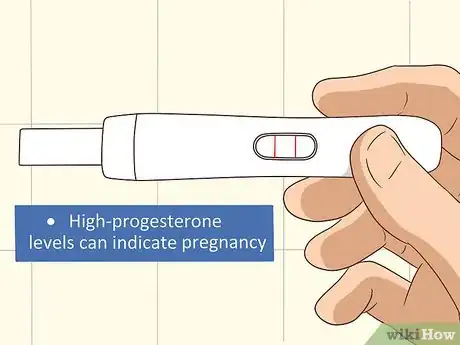This article was medically reviewed by Erik Kramer, DO, MPH. Dr. Erik Kramer is a Board-Certified Primary Care Physician at the University of Colorado. With over 15 years of experience, his clinical interests include obesity and weight management, diabetes care, and preventive care, as well as embracing a holistic approach to primary care. He received his Doctorate in Osteopathic Medicine (D.O.) from the Touro University Nevada College of Osteopathic Medicine and completed his residency at Central Maine Medical Center. Dr. Kramer is a Diplomate of the American Board of Obesity Medicine.
There are 10 references cited in this article, which can be found at the bottom of the page.
This article has been viewed 86,200 times.
Progesterone is a hormone produced in the ovaries of women that helps regulate your menstrual cycle and prepares the body for conception and pregnancy.[1] Too much progesterone is typically not the cause of too many serious health conditions, though it can cause mood swings, sweating, feelings of menopause,[2] and put you at higher risk for breast cancer.[3] Since it can indicate a more severe condition, ask your gynecologist to run a diagnostic test to check your levels. With a few lifestyle changes as you approach menopause, you can decrease your progesterone levels naturally.
Steps
Making Lifestyle Changes
-
1Get an hour of aerobic exercise most days of the week. Getting enough exercise can help lower your progesterone levels,[4] particularly if you are getting close to menopause. One study showed progesterone levels went down by almost 25% after exercising for 7 months.
- If you're not used to exercising that much, start small and work your way up. Even a few minutes a day can help you on your way.
-
2Quit smoking to lower progesterone production. Nicotine tends to increase adrenal activity, which can shift your balance of hormones, including progesterone production. If you stop smoking, you may find it easier to balance out your body, including your progesterone levels.[5]
- Make quitting a priority. Talk to your doctor about ways they can help.
- Let your friends and family know you're quitting, so they can help you when the cravings hit.
Advertisement -
3Avoid excessive caffeine. Though a daily cup of coffee won’t affect your progesterone levels, multiple energy drinks or large amounts of caffeine could cause high levels of progesterone.[6] Limit yourself to 300-400 mg of caffeine per day at maximum.[7]
- Caffeine is in many sodas, coffee, tea, energy drinks, and even chocolate.
Talking to Your Doctor
-
1Request a pregnancy test from your doctor. You can also take one at home. High progesterone levels can indicate pregnancy,[8] so you want to rule this out before you start other treatments.
- Try to wait a week after the first day of your missed period to do a home pregnancy test, as it will be more accurate then.[9]
-
2Expect a blood test. If you notice any mood swings, tenderness in the breasts, or signs of menopause, your doctor will want to perform a blood test. The blood test can help them determine the best treatment to lower your progesterone levels if they are high.[10]
- "Normal" progesterone levels vary by where you are in your cycle. Before you ovulate, normal levels are less than 1 nanogram per milliliter (ng/mL) or 3.18 nanomoles per liter (nmol/L). In the middle of your cycle, normal levels are between 5 and 20 ng/mL or 15.90 and 63.60 nmol/L.
- For men, normal is less than 1 ng/mL or 3.18 nmol/L.
-
3Discuss cancer screening. Possible causes of high progesterone levels are certain types of cancer that can throw your hormones off balance. Adrenal cancer and ovarian cancer are 2 possibilities.[11]
- It's important to not jump to any conclusions based on high progesterone levels. Wait for diagnostic tests to know for sure, as it could be a simple fix.
References
- ↑ https://www.yourhormones.info/hormones/progesterone/
- ↑ https://www.healthywomen.org/your-health/progesterone
- ↑ https://www.cancer.gov/about-cancer/causes-prevention/risk/hormones
- ↑ https://www.ncbi.nlm.nih.gov/pmc/articles/PMC4842443/
- ↑ https://www.shecares.com/hormones/progesterone/causes-high-levels
- ↑ https://www.shecares.com/hormones/progesterone/causes-high-levels
- ↑ https://www.caffeineinformer.com/caffeine-safe-limits
- ↑ https://medlineplus.gov/lab-tests/progesterone-test/
- ↑ https://www.mayoclinic.org/healthy-lifestyle/getting-pregnant/in-depth/home-pregnancy-tests/art-20047940
About This Article
Progesterone is a hormone produced in your ovaries that helps regulate your menstrual cycle. High progesterone levels can cause mood swings and excess sweating. It can also indicate pregnancy, so it’s important to take a test to rule this out before you treat it. If you’re not pregnant, you can help lower your progesterone levels by doing a few hours of aerobic exercise a week, like jogging, dancing, or swimming. You should also avoid drinking more than a couple of caffeinated drinks a day, since caffeine can raise your progesterone levels. If you smoke, try to cut down and stop, as nicotine is another common cause of high progesterone. High progesterone levels can sometimes be a sign of cancer, so talk to your doctor if you're not able to lower your progesterone levels on your own. For more tips from our Medical co-author, including how to test your progesterone levels, read on.


















-Step-12-Version-2.webp)















































Medical Disclaimer
The content of this article is not intended to be a substitute for professional medical advice, examination, diagnosis, or treatment. You should always contact your doctor or other qualified healthcare professional before starting, changing, or stopping any kind of health treatment.
Read More...